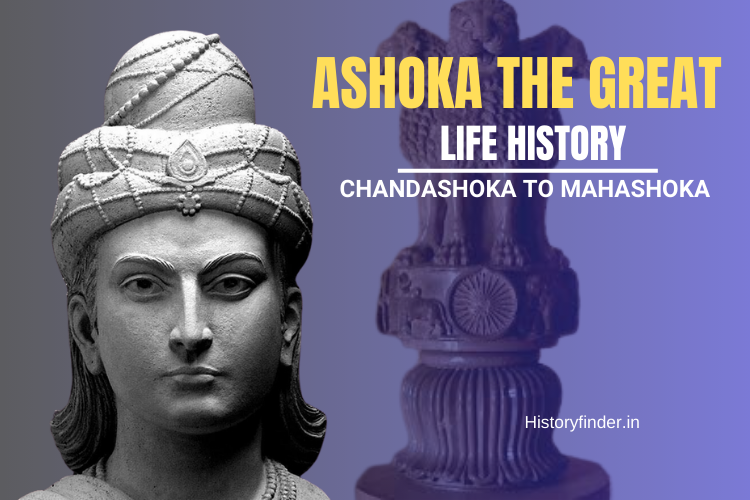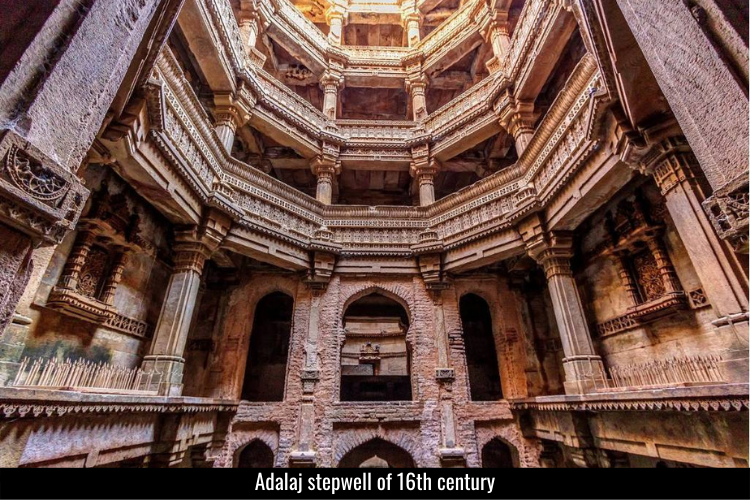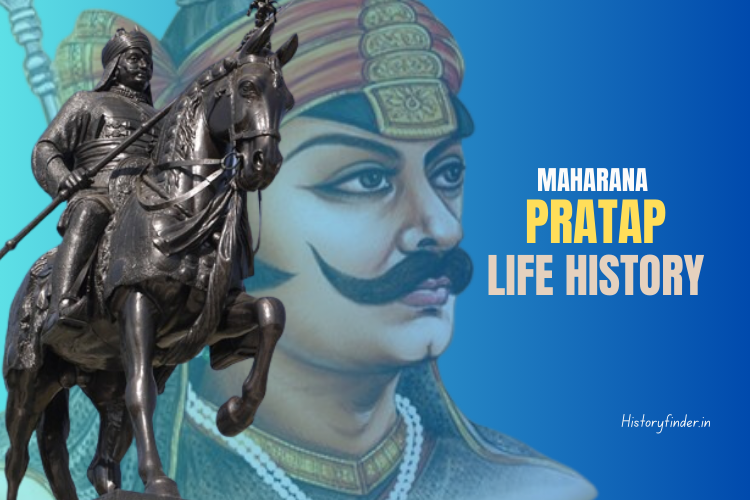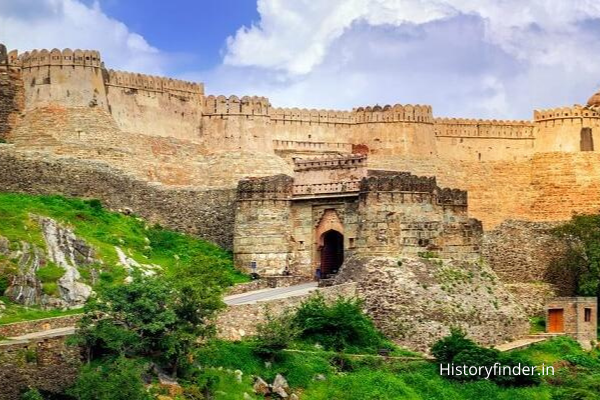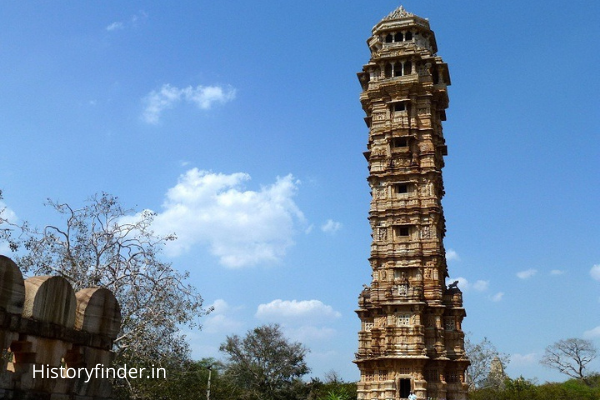Emperor Ashoka was the third ruler of the Maurya Dynasty. Ashoka the great life history is often remembered among the great Indian emperors. The third Mauryan king took the Mauryan empire to its zenith. His reign (268-232 BCE) had brought a massive religious transformation in Indian history. Samrat Ashoka the great is widely famous for his many rock and pillar edicts. He was the only king in India, who publicly announced his grievances and renounced armed conquest.
Emperor Ashoka’s efforts to spread Buddhism across Asia was highly recognized. But, early life history of Ashoka characterizes struggle, followed by cruelty. Ashoka’s edicts unfold a lot of information about his reigns, especially his later life. But major information about Ashoka life history comes from three literary Buddhist sources – Ashokavadana, Dipavamsa and Mahavamsa.
Early Life (304–268 BCE)
Although the Puranas have mentions about Ashoka but nothing about his life unfortunately. Major information about early life history of Ashoka the Great comes from the ancient Buddhist texts. However, in many respects, all these references are more legendary than historical.
Actual date of birth of Ashoka the great is unfortunately debatable. Ashoka was born around 304 BCE to the second Mauryan king Bindusara, and his second queen Subhadrangi alias, Dharma. The word Ashoka means ‘without sorrow’ in Sanskrit. Being daughter of a poor Brahmin family, Maharani Subhadrangi, suffered a very tough period in her early life. Maharani Subhadrangi, had perhaps, named his son Ashoka, hoping for an struggle free life for her son.
But the prays of Maharani Subhadrangi didn’t work for Ashoka. According to Buddhist text Ashokavadana, even Maharaja Bindusara disliked rough, ugly skinned Ashoka. His brothers were often disrespectful with him as well.
Multi-skills of Ashoka
Prince Ashoka was multi-talented from his young age. Ashokavadana mentions about how highly educated Ashoka was in the court of Bindusara. Ashoka’s edicts clearly depict that Ashoka also had a great sense of Arthashastra. As a warrior, Ashoka had supreme skills in martial arts and other weaponry and military tactics. There is no doubt that Ashoka’s multi-directional skills often impressed his father Bindusara.
Revolt of Takshashila
Maharaja Bindusara sent the 18 years old Ashoka to neutralize the revolt of Takshashila (Taxila, in modern Pakistan). An Ashokavadana legend mentions that Bindusara had sent Ashoka to his expedition of Takshashila without giving him any weapons. Later, some supernatural powers provided him the weapons. Ashoka was merciful to the rebels who laid down their arms. However, the rebels expressed later that the revolt was only against the bad ministers, and never against the emperor.
The bloodless solution of Takshashila revolt impressed Bindusara a lot. Rightly recognizing his talents, also appointed Ashoka as the governor of Avanti province of Magadha.
Conspiracy by Susima: Exile of Ashoka
Susima and his mother constantly conspired against Ashoka. In facts, Ashoka always had the lowest status among all the princes. Susima convinced Maharaja Bindusara to suppress the revolt at Taxila (presently in Pakistan). But it soon backfired as Ashoka neutralized the revolt without any bloodshed. Further, Ashoka won heart of the people of Taxila.
Sushima began inciting Bindusara against Ashoka. Maharani Subhadrangi adviced Ashoka to leave Pataliputra and avoid the situation. Nevertheless, Maharaja Bindusara sent Ashoka in exile for two years. Ashoka went to Kalinga (presently, Odisha) during his exile period.
Maharaja Bisndusara’s other wife, mother to his eldest son Susima, was a princess, hence, extremely influential. So, Susima was always ahead of Ashoka in line of the throne. It made king Ashoka went through a long struggle, before he emerged as a strong contender of Mauryan throne. Anyways, Ashoka the great eventually ascended the throne around 268 BCE, post many violent conflicts and wars of succession.
Revolt of Ujjain: Ashoka’s first interaction with Buddhism
Another revolt at Ujjain forced Maharaja Bindusara bring Ashoka back and send him to Ujjain. Ashoka, with his extraordinary warfare tactics, suppressed the rebels again. But this time, Ashoka got injured and got treatments secretly from the Buddhist monks. Undoubtedly, it was the first interaction of Ashoka with Buddhist culture.
Marital Life of Ashoka: Wives and Children
Ashoka had five wives and six children: four sons and two daughters. Buddhist chronicles mention very few details about his wives and children.
During his tenure as the governor of Ujjain, Ashoka came in relation with Devi, daughter of a merchant of Vidisha. She eventually became the first wife of emperor Ashoka. Devi and Ashoka gave birth of two children: Mahinda (or, Mahendra) and Sanghamitta. Unfortunately, empress Devi couldn’t get the status of chief empress, for not belonging from a royal family. According to Buddhist texts, Devi was already a Buddhist who introduced Ashoka with Buddhism for the first time. Later Mahendra, first son of Ashoka led the Buddhist mission to Sri Lanka.
Ashoka’s second wife Asandhimitra, likely from a royal family, was the first empress consort (chief empress). She didn’t have any children. But she likely to have adopted a daughter Charumati.
Padmavati was the third wife of Ashoka the great. Emperor Ashoka and empress Padmavati gave birth to Ashoka’s second son Kunala, who became the crowned prince.
Kaurvaki was the fourth wife of Ashoka whom he met during his exile to Kalinga. Ashoka and Kaurvaki love story was an import phase of Ashoka the great life history. Maharaja Ashoka and Maharani Kaurvaki gave birth to their son Trivala.
After Maharani Asandhimitra died, Maharani Tishyarakshita, the fifth wife of Ashoka, became the chief empress. According to the ancient Buddhist text Ashokavadana, she had blinded the crowned prince Kunala.
Rajatarangini, a famous Kashmiri text by Kalhana, describes about the fourth son of Ashoka, who became the king of Kashmir.
Early Reign of Ashoka the Great (268–261 BCE)
During Ashoka’s tenure as the governor of Ujjain, another revolt occurred at Takshashila. But this time, Maharaja Bindusara decided to send Susima to Takshashila. While Susima, the crowned prince, was busy with the rebels, Bindusara fell ill and hence recalled Susima. But the ministers helped Ashoka to ascend the throne of Magadha. After ascending the throne, he executed his brother Susima, by throwing him in burning charcoal pit. Ashoka killed all his brothers who were not good with him. Vitashoka, his youngest brother, renounced all claim of Magadha’s crown and became a Buddhist monk.
Ashoka ascended the throne of Magadha about at the age of 36 years. The first 8 years of his reign marks consolidation and expansion of Mauryan Empire to its utmost stretch. Ashoka expanded Mauryan empire up to Afghanistan to the west and Bangladesh to the east. Almost entire Indian subcontinents came under his control. He focusing on military conquests, centralized governance and maintained the policies of his predecessors.
The early reigning era characterizes the life history of Ashoka the great as a ruthless emperor. The world named him Chandashoka for his cruelty. During this period, he was known for being a fierce and ruthless ruler, crushing revolts and expanding the empire’s borders. Ashokavadana describes Ashoka’s hell, the torture chamber of Ashoka for treating the prisoners. The treatments for the prisoners included pouring boiled copper through their throats. Agam Kuan, an archaeological site of Patna, is now characterized as Ashoka’s hell.
The Kalinga War (261 BCE) and Aftermath
Kalinga War, the brutal infamous battle, brought a dramatic change in life history of Ashoka the great. It was the only unconquered state of eastern subcontinent, became very wealthy and prosperous through sea route trades. Although actual reason is unknown, but these were the probable reasons behind Ashoka’s Kalinga invasion.
Kalinga War resulted in deaths of over 100,000 soldiers and civilians and deporting 150,000 more. While having a walk through the battle field, the death and destruction led a profound change in his heart. He realized another several thousands of deaths of diseases and famine.
In his 13th major rock edict, Ashoka renounced violence and also stated his successors would follow that as well.
This conquest, which has been won by this everywhere; causes the feeling of satisfaction… But this satisfaction is indeed of little (consequence). King Devanampriya (Ashoka) thinks that only the fruits in the other (world) are of great (value)..
..And for the following purpose has this rescript on morality been written, (viz,) in order that the sons (and) great-grandsons (who) may be (born) to me, should not think that a fresh conquest ought to be made; (that), if a conquest does please them, they should take pleasure in mercy and light punishments; and (that) they should regard the conquest by morality as the only (true) conquest.
– English translation of Ashoka’s 13th major rock edict.
Conversion to Buddhism (261–232 BCE)
It is said that good and evil exist within a human, only thing is one needs to realize the good. Ashoka’s goods overpowered his evils after the Kalinga War. Maharaja Ashoka embraced Buddhism and became a devout patron. He, perhaps, studied under Buddhist monks and actively participated in the Buddhist community as well. His began promoting the principles of Dhamma (Dharma), which emphasized non-violence, compassion, and respect for all life.
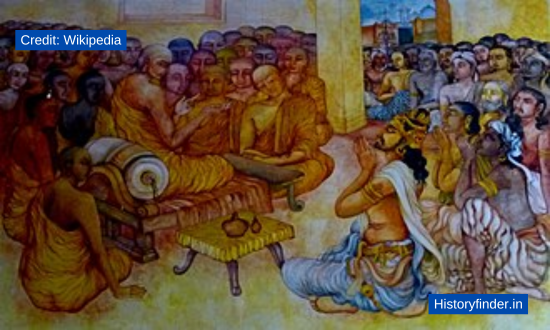
Ashoka’s reign played a crucial role in spread of Buddhism, not only within India, but also abroad. He sent Buddhist missionaries to various regions, including Sri Lanka, South and Central Asia, and the Mediterranean countries. His son Mahinda, and daughter Sanghamitta, played pivotal role to promote Buddhism in Sri Lanka.
Ashokan rock and pillar edicts mark his success in spreading Buddhism across a large number of countries. Ashoka inscribed his messages of Dharma, advocating moral and ethical behavior, religious tolerance, and the protection of life. Ashokan edicts, written in Prakrit, Greek, and Aramaic languages, still surviving in modern-day India and Pakistan and Afghanistan.
Ashoka brought administrative and social reforms in his empire, according to the Buddhist principles. He constructed hospitals, roads, rest houses, and wells across his empire. Ashokan edicts advocate kindness toward all living beings. He also restricted animal sacrifices, limited to food only.
Final Years and Death of Ashoka
According to the Ashokavadana, the greatest king in Indian history, fell severely ill during his last days. Ashoka donated everything from his personal possessions to the Buddhist sanghas. In facts, he started donating from state treasury. It prompted his ministers deny him access to the state treasury. On his deathbed, he offered his final possession to the sangha, half of a myrobalan fruit, as his last donation.
Ashoka died in 232 BCE due to severe illness, at the age of around 72 years. Death of Ashoka led to a slow decline of the great Mauryan Empire.
Legacy of Ashoka the Great
Ashoka’s transformation from a ruthless conqueror to a peaceful, morally-driven ruler has made him a symbol of ethical leadership. His non-violence, and tolerance policies stay highly respected. Ashoka’s efforts to promote Buddhism led to its spread far beyond India’s borders. Buddhist missionaries traveled to various regions under his patronage, turning Buddhism one of the major religions in the world.
Ashokan rock and pillar edicts unfold critical insights into his policies and the spread of Buddhism. The famous Lion Capital of Ashoka, found at Sarnath, is now India’s national emblem.
Ashoka’s legacy has left an enduring mark on Indian culture, politics, and social life. His policies are now taken as a model for good governance and administration, combining strength with compassion.
Summarizing, Ashoka the Great’s life journey from a ruthless conqueror to a devout Buddhist ruler marks a great transformation. His efforts to execute socio-political reformation was way ahead of his promotion of Buddhism and Dharma. Ashoka’s transformation was from the evil to the good, which the entire empire witnessed. Later, with the spread of Buddhism, his policies were acknowledged by many other kingdoms.
